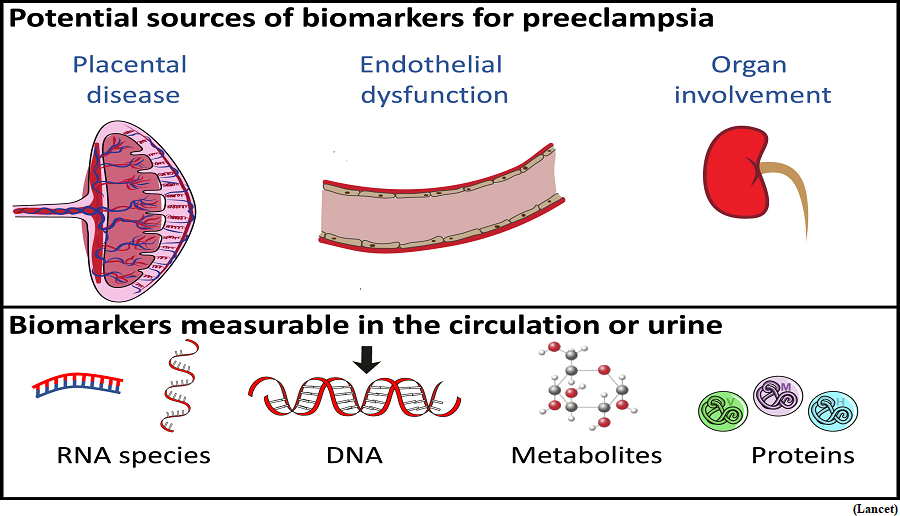Early prediction of preeclampsia using a biomarker (GS Paper 3, Science and Technology)

Why in news?
- A liquid-biopsy approach that measures DNA-methylation levels in the blood may improve the detection of pregnancies at risk of developing preeclampsia at early stages, a recent study shows.
About Preeclampsia:
- Preeclampsia is a major cause of morbidities during gestation. Early-onset preeclampsia, occurring before 34 weeks of gestation is associated with a higher risk of severe disease and foetal mortality.
- Among the few interventions available, low-dose aspirin at early stages of the disease (before 16 weeks of gestation) can reduce the risk of developing preeclampsia, but early identification of the disease is needed to initiate this intervention.
- Previous studies have shown that widespread methylation changes in the placenta occur at delivery.
Recent research:
- Researchers profiled blood DNA-methylation data from 498 pregnant women, about one third of whom developed preeclampsia.
- They detected differences in DNA methylation in the control pregnancies versus the pregnancies that developed preeclampsia.
- Using these data, they developed a model that enabled risk stratification not only when preeclampsia was diagnosed but also presymptomatically, at around 12 weeks of gestation.
- In a further analysis involving 197 of these women, they showed that this model, in combination with clinical and demographic risk factors, generated a risk score that correctly predicted 72% of patients with early-onset preeclampsia.
Way Forward:
- The preliminary results suggest that cell-free DNA methylation profiling is a promising tool for presymptomatic PE risk assessment, and has the potential to improve treatment and follow-up in the obstetric clinic.
Pragyan rover completes its assignments, set into sleep mode
(GS Paper 3, Science and Technology)
Why in news?
- After transversing over 100 meters on the lunar surface from the Shiv Shakti Point, the touchdown spot of the Vikram lander on the lunar surface, the Pragyan Rover has been safely parked and set into sleep mode.
- The next sunrise is expected on September 22, 2023, and hoped for a successful awakening for another set of assignments.

Natural event recorded:
- Earlier ISRO said that the Pragyan Rover module of the Vikram lander has recorded a natural event on the south pole of the moon.
- In-situ Scientific Experiments Instrument for the Lunar Seismic Activity (ILSA) payload on Chandrayaan 3 Lander, the first Micro Electro Mechanical Systems (MEMS) technology-based instrument on the moon has recorded the movements of Rover and other payloads.
Chandrayaan-3 mission has three components:
- The propulsion module, which transferred the lander and the rover module to 100 kilometres of lunar orbit,
- The Lander module, which was responsible for the soft landing of the lunar craft and
- The Rover module, which is for exploring components on the moon.
Background:
- India took a giant leap on August 23, as the Chandrayaan-3 lander module successfully landed on the moon's South Pole, making it the first country to have achieved the historic feat.
- The country became the fourth- after the US, China, and Russia - to have successfully landed on the moon's surface.
Cells with minimal genome can evolve as fast as normal cells
(GS Paper 3, Science and Technology)
Context:
- Complex organisms like humans contain thousands of genes, most of which are not essential for survival. Mutations in these genes are not lethal. Evolutionary forces can act on these genes, and any beneficial mutation becomes more abundant over time.
- But what if a simple organism contained only those genes essential for its survival?

Details:
- Researchers from Indiana University, Bloomington, used a synthetically designed minimal cell containing only genes essential for survival to answer this question. Their findings showed that even such a cell can evolve as fast as a normal cell.
Basis of research:
- They used a synthetic version of Mycoplasma mycoides, a microbe commonly found in the guts of cattle.
- They created a stripped-down minimal cell (JCVI-syn3.B) with only 493 genes, down from the 901 genes in the non-minimal strain (JCVI-syn1.0). Although the minimal cells were alive and could reproduce, genome minimisation also reduced their fitness.
- To test whether these minimal cells responded differently to the forces of evolution compared to non-minimal cells, they grew them separately in a liquid medium, transferring a small, fixed amount of the population into fresh medium every day. They did this for 300 days, allowing the bacterial lineage to pass through 2,000 generations.
- In this time, the minimal cells’ mutation rate was comparable to that of non-minimal cells. And Mycoplasma mycoides has the highest recorded mutation rate for any cellular organism.
Observations made:
- Over 300 days, they found that the minimal cell also regained all the fitness it had lost due to genome minimisation and could perform as well as the non-minimised cell.
- But the minimal cell grew to be smaller than the non-minimal cell: the size of the non-minimal cell increased by 80% over 300 days whereas the minimal cell remained the same size.
- When they examined the genomes of the adapted cells, they found that the minimal and non-minimal cells improved their fitness and evolved via distinct genetic pathways.
Significance:
- The finding that the evolutionary potential of organisms remains high despite their distinct evolutionary trajectories is a very significant contribution to understanding of microbial evolution.
- The study sheds some light on how synthetic organisms might change when confronted by the inevitable forces of evolution.




